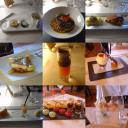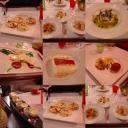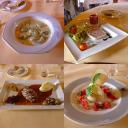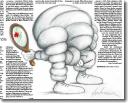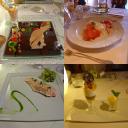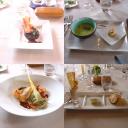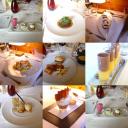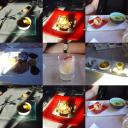Change comes slowly to a village like Entre-deux-Eaux. But when we heard about the death of Mme Colnat, it set me thinking about the last 16 years that we’ve known the village.
For M. and Mme Colnat were the first people we talked to here. We’d idly looked at the shuttered-up old farmhouse that is now ours, then we’d retreated to the cool of the village shop-cum-bar. In those days it was run by the Colnats. M. Colnat had inherited the shop from his father. He’d grown up there. As a young man he’d played his accordion on Saturday nights for the village dances and weddings. Later he’d delivered supplies to the outlying farms. I expect that on that first occasion we met he would have been wearing a thick grey overall or a blue one as he did after he retired. And she would have been hovering, thin, wispy and a little nervous in a floral overall behind the counter.
The shop as it was then seemed very dark. It had huge piles of felt slippers to the left, earthy vegetables in front and a counter with butter, cheese, meats and bread to the right. From the ceiling hung strips of disgusting, encrusted fly papers. And the floor was an expanse of wooden floorboards – well mopped, but unpolished, which stretched out to the back, opening up into an equally dark bar.
They were friendly and interested, but with that Vosgian reserve, as we asked about the farmhouse. Oh yes, they knew the Fresse house. They chatted pleasantly. But M Colnat never mentioned that Mme Fresse was his aunt. Perhaps they took it for granted, as everyone at this end of the village was related to the Fresses. Later Mme Colnat told us that she grew up in a big house right in the forest, over the hills from here. She was the daughter of a Cossack who’d stayed on at the end of the First World War. So perhaps that gave her some sympathy with outsiders coming into the village.
Each time we returned to the village for a week here and a week there, our first trip would be down to the village shop to place our daily order for baguettes and to get a newspaper and a welcome back. The period leading up to their retirement was an anxious one, as no one wanted to purchase a village shop. They even asked in desperation if any of our friends would like to come and own a French épicerie! Eventually the commune purchased the building and renovated it and included four apartments. During renovation the shop shrank in size, and its stocks dwindled as many people now did their main shopping at the St Dié supermarkets. But the bar became much larger, brighter and busier, especially before lunch time. The muscular-legged new lady shopkeeper dashes energetically between the gossip of old ladies in the shop and the loud banter of men in the bar.
And meanwhile M and Mme Colnat moved up the short hill that leads up to the church, to a small bungalow with a walled garden. But even so close to the centre of the village, Mme Colnat missed her daily contact with so many people. She found it very quiet. She had her garden to tend, and would go for long walks; in autumn looking for mushrooms. But as she got increasingly frail and forgetful, her husband got more anxious about her going far afield. Her heavy smoking was catching up with her too.
I remember one scene vividly. A friend, Ann, and I had been wandering round the churchyard, and she’d spotted us from her house and come out for a chat. We sat on the seat under the huge old tree between the steps up to the church and her house, and she introduced a neighbour and we all chatted happily. Suddenly both women leapt up as they’d heard Vozelle’s cows approaching. They stretched out their arms to head off the lean cows (for whom all grass seemed greener) from going into any gardens, including their own. Then they returned to the seat, clucking at the late hour (mid-day) for the cows going out to graze, and at Vozelle’s limp which resulted from a stroke, and now seemed worse than ever.
Apparently for some time now, our mayor has been trying to persuade Vozelle to give up his hand-to-mouth farming existence (not to mention all his debts) and to take his pension now rather than later. But maybe, despite the handicap of his limp (and neighbouring farmer Duhaut used to say maliciously that he only limped when people were around), Vozelle could not imagine a life without his beasts. So it was particularly sad to hear that shortly before Christmas, when Vozelle had failed to pay yet another bill or debt, the bailiffs arrived to take away all his herd. One of the cows managed to evade capture and broke free, but we haven’t heard what finally happened to it. We didn’t see it wandering around afterwards (years ago we’d found one outside our front door one morning, which had failed to make it home for milking in the dark of the night before). His farm machinery now lies abandoned in the mud around their house, and their chickens and dogs still race cars on the lane, which they regard as their property. But we shall miss coming home late at night behind a slow moving herd of cows, or finding blue string stretched taut across the road outside their cowshed.
Farmer Gaunand, by contrast, retired some years ago with dignity, doing land and animal deals with farmer Duhaut. He still lives in his family house, which is the finest house in Entre-deux- Eaux, (on the corner beyond the village shop, opposite Vozelle’s brother’s house with its plaster storks on the gateposts). His mother was reputed to keep the best cellar in Entre-deux-Eaux. His petite elegant wife still tends her garden in her smart clothes and high heels. Two of the family’s smaller houses have been converted into gîtes. If ever the village were to run a best floral decoration competition, Mme Gaunand’s overflowing geranium pots, troughs and window boxes would definitely win.
So the four main farmers who farmed the intriguingly named strips of pasture in and around the village (with names like le rêve pre, les pres des truches) have been reduced to two even bigger farmers during the sixteen years we’ve been here. None of the four have children who wanted to follow in their footsteps, for they have moved away from the village to other occupations.
But the third big change is that other young people are choosing to stay in the village or to move into it. When we first came here there were seven houses on rue du Mont Davaux (though no road names or house numbers to guide you – and according to the phone directory we shared a house number with another family further down the road!) Now there are fifteen houses, our road has a name plate, and, following the renumbering of the subdivided plots, the houses now have a smart brown and beige numbers (we are now 13 rather than 7, but don’t feel any the unluckier for the change). The cheapest way for young couples to acquire their own house seems to be to buy a plot of land and commission a local builder to put up a shell which they then complete using sub-contractors and friends and family. So houses are growing up like mushrooms throughout the commune where urbanisation is allowed (our end of rue du Mont Davaux is outside the zone). One house was built for the present shopkeeper’s daughter, and another by M and Mme Laine’s grandson, Ludo, with help from his Portuguese builder mates. “So handy to have him next door now we are getting old”, the Laines murmur happily, as they bask in the unexpected February sunshine on their balcony. Purple gauze curtains and indoor palms seem to be taking over from sturdy brown shutters and beds of leeks and cabbages. Will we one day be no more than a dormitory village for St Dié?
Of course, a few people are moving away. For us the biggest loss has been Nicola. She first contacted us from Chicago in the mid-90s to see if we were prepared to let our farmhouse to her and two dogs for several months. But as we used our house more often than that, we put her in contact with Mme Gaunand. So she stayed in the very traditional (and cold) gîte next to the Big House until she found a house to rent in Clefcy. She had been a botanical and commercial artist, but soon began to paint local Vosgian landscapes and villagers at work, which she exhibited at the annual St Dié art show and during the local art week. She quickly found her feet as a full-time resident here, and each time we returned would drag us off to flea markets, exhibitions and garden centres she’d discovered. But on her sixtieth birthday she decided she was ready for a change of lifestyle and joined a dating agency. After a whirlwind romance this summer, John from Devon moved in with her, and they began to make plans to move down to the south. And so it was that, in November when we celebrated her ten years in the Vosges, it was a rather dispiriting meal at one of her favourite restaurants. She and John were tired after their house hunting trips and we were sad at the prospective loss. A laden removal van finally left for the Languedoc two weeks ago.
So if any one fancies a bright, airy artist’s house in Clefcy, Nicola’s is now on the market! You might even get a cat to go with it. The move appears to be one change too many for Felix. Despite being born to a semi-wild mother under a pile of old roof timbers below our vegetable patch, he adapted well to a life of creature comforts at Clefcy after Nicola rescued all the litter from being drowned (in our absence). He even put up with the two Chicago cats. But the big move down to the Mediterranean was a change he was not prepared to tolerate. Or was it just his nomadic heritage re-asserting itself? He bolted a week ago.
You may get the impression from these meditations on change, that there have not been many current happenings to write about. That’s largely due to a sedentary lifestyle since my hysterectomy operation in St Dié at the end of January. And the more I hear about UK waiting lists, ambulance queues outside hospitals and hospital infections, the more thankful I feel that I was able to have it done in a calm hospital, with only single or double rooms and immaculate standards of cleanliness. There were a few language problems, but you’ll be glad to hear that following hilarious mime sessions with the nurse I now know the correct French terms for crapping and farting. I also had a wonderful view of the mountains as the hospital is at the top of a steep hill in Saint Dié!
However, since John has also spent the time peacefully at his computer, you too can reflect on our more recent years here, through the new improved website, not to mention some of the latest restaurant pictures. Now who would have thought “le hamburger” would have become quite so trendy at the Auberge Frankenbourg (even if it was hiding a piece of fillet steak)?
I could go on about the changes in the weather – so sunny and mild this winter, compared with the long months of snow last year. But then everyone’s saying similar things about the milder winter and increase in debilitating infections in the UK, so I won’t dwell on that. Perhaps the nicest way to conclude would be with the reminiscences (round a kitchen table) of a man from the adjoining hamlet of Rememont (part of our commune), which really summarise the changes:
“We used to have four cafés in Rememont and 250 cows. Now there are no cafés and hardly any cows.”
Click on this link E2Eyear5weeks28-43.pdf to download Adobe Acrobat version
